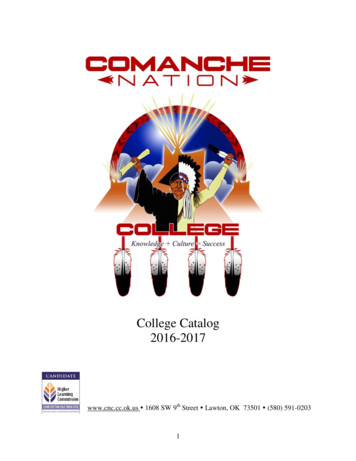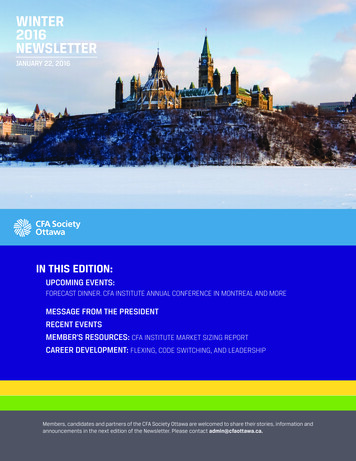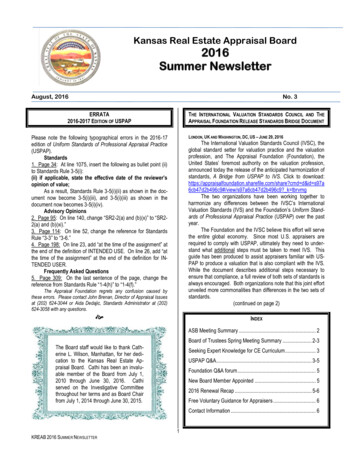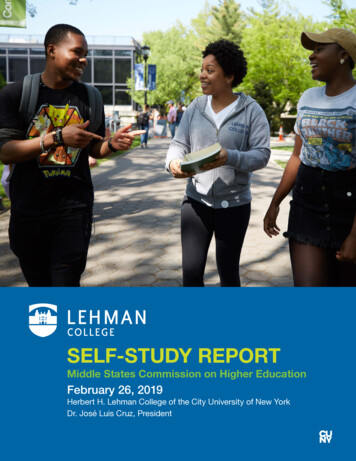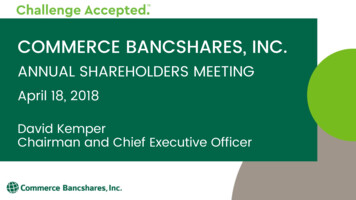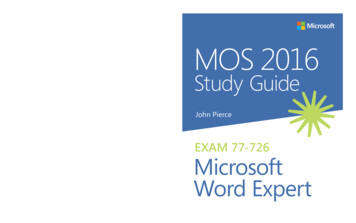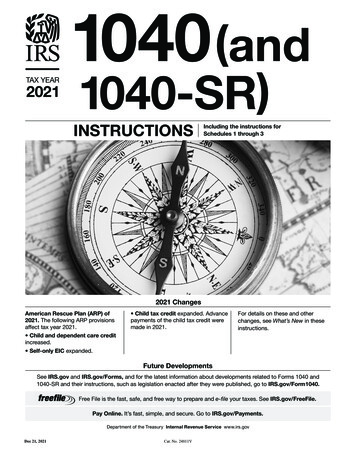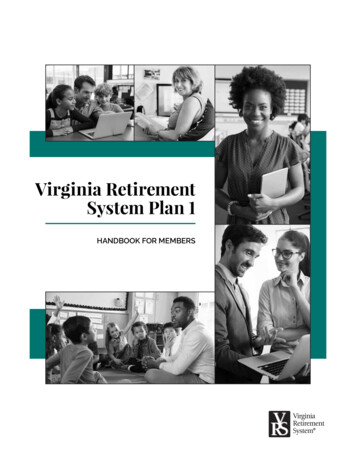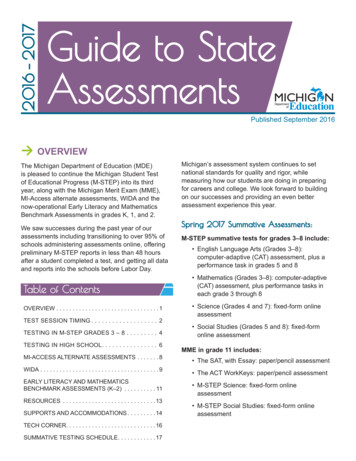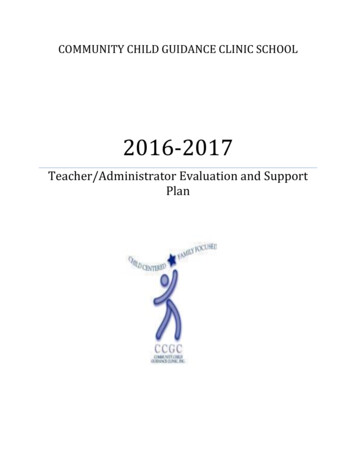
Transcription
COMMUNITY CHILD GUIDANCE CLINIC SCHOOL2016-2017Teacher/Administrator Evaluation and SupportPlan
12016-2017 Community Child Guidance Clinic School Teacher Evaluation andSupport PlanOverviewThis document contains the major components of the multiple measures needed to evaluateteachers as mandated by the Connecticut State Department of Education (CSDE). This plan willdetermine a comprehensive level of teacher performance for educators in an Approved PrivateSpecial Education Programs (APSEP), Community Child Guidance Clinic School. The CSDErequires that all teachers receive an annual summative rating in one of four performance levels.The rating is determined based on performance in the areas of teacher performance and practice(40%), parent/ peer feedback (10%), student growth and development (45%), and studentfeedback or whole school improvement for student learning goal (5%).Scores from each of the four components will be combined to produce a summative performancerating designation of Exemplary, Proficient, Developing or Below Standard. The performancelevels are defined as: Exemplary – Substantially exceeding indicators of performanceProficient – Meeting indicators of performanceDeveloping – Meeting some indicators of performance but not othersBelow Standard – Not meeting indicators of performance
2Teacher Evaluation Process and TimelineThe annual evaluation process between a teacher and an evaluator (Educational Director) isanchored by three conferences, which guide the process at the beginning, middle and end of theyear. The purpose of these conversations is to clarify expectations for the evaluation process,provide comprehensive feedback to each teacher on his/her performance, set developmentalgoals and identify development opportunities. These conversations are collaborative and requirereflection and preparation by both the evaluator and the teacher in order to be productive andmeaningful.Goal Setting and Planning(By October 30) Orientation on process Teacher reflection andgoal-setting Goal-setting and plandevelopmentMid-Year Check- in(By January 15) Review goals andperformance to dateMid-year conferencesEnd of Year Review(By June 1) Teacher selfassessment Rating End of year conferenceGoal-Setting and Planning:Timeframe: Completed by October 301. Orientation on Process – To begin the evaluation process, the Director of Educationwill meet with teachers, in a group and discuss the evaluation process and their rolesand responsibilities within it. In this meeting, they will discuss any school prioritiesthat should be reflected in teacher practice focus areas and Student LearningObjectives (SLOs), and they will commit to set time aside for the types ofcollaboration required by the evaluation and support process.2. Teacher Reflection and Goal-Setting – The teacher examines student data, prioryear evaluation, survey results, and the CCT Rubric for Effective Teaching 2014 todraft a proposed performance and practice focus area, a parent feedback goal, twoSLOs and a student feedback goal (if required) for the school year. The teacher maycollaborate in school wide teams to support the goal-setting process.3. Goal-Setting Conference – The Director of Education will meet with the teacher todiscuss the teacher’s proposed focus area, goals and objectives in order to arrive atmutual agreement about them. The teacher collects evidence about his/her practiceand the evaluator collects evidence about the teacher’s practice to support the review.
3Mid-Year Check-In:Timeframe: Completed by January 151. Reflection and Preparation – The teacher and evaluator collect and reflect onevidence to date about the teacher’s practice and student learning in preparation forthe check-in.2. Mid-Year Conference – The evaluator and teacher complete one mid-year check-inconference during which they review evidence related to the teacher practice focusarea and progress towards SLOs and other goals. If needed, teachers and evaluatorscan mutually agree to revisions on the strategies or approaches used and/or mid-yearadjustment of SLOs to accommodate changes (e.g., student populations,assignment).They may also discuss actions that the teacher can take and supports theevaluator can provide to promote teacher growth.End-of-Year Summative Review:Timeframe: May and June; must be completed by June 11. Teacher Self-Assessment – The teacher reviews all information and data collectedduring the year and completes a self-assessment for review by the evaluator. Thisself-assessment may focus specifically on the areas for development established inthe Goal-Setting Conference.2. End-of-Year Conference – The evaluator and the teacher meet to discuss allevidence collected to date and to discuss component ratings. Following theconference, the evaluator assigns a summative rating and generates a summary reportof the evaluation before the end of the school year or before June 1.3. Scoring – The evaluator reviews submitted evidence, self-assessments andobservation data, then uses them to generate component ratings once the end-of-yearconference has taken place. The component ratings are combined to calculate scoresfor Teacher Practice Related Indicators and Student Outcomes Related Indicators.These scores generate the final, summative rating. After all data, including state testdata, are available, the evaluator may adjust the summative rating if this data wouldsignificantly change the Student Outcomes Related Indicators final rating. Suchrevisions should take place as soon as state test data are available and beforeSeptember 15.Evaluator Training and CalibrationAll evaluators of teachers will receive ongoing training on conducting effective observations andproviding quality feedback. Training may include participation in CSDE Teacher EvaluationTraining workshops and other CSDE provided opportunities. The Educational Director willcontinue training by viewing leadership videos and the Connecticut Common Core of TeachingEvaluation Rubric.
4Teacher Practice Related IndicatorsTeacher Performance and Practice (40%)The Teacher Performance and Practice category is a comprehensive review of teaching practiceconducted through multiple observations, which are evaluated against a standards-based rubric.It comprises 40% of the summative rating. Following observations, evaluators provide teacherswith specific feedback to identify strong practice, to identify teacher development needs and totailor support to meet those needs.The CCT Rubric for Effective Teaching 2014 is aligned with the Connecticut Core of Teachingand includes references to Connecticut Core Standards and other content standards. The CCTRubric for Effective Teaching 2014 is organized into four domains, each with three indicators.Forty percent of a teacher’s final annual summative rating is based on his/her performanceacross all four domains. The domains represent essential practice and knowledge and receiveequal weight when calculating the summative Performance and Practice rating.Bloomboard will be used to document the process of teacher observation and practice. Eachteacher will be observed between three and eight times per year through both formal andinformal observations as defined below. Formal: Observations that last at least 30 minutes and are followed by a postobservation conference, which includes timely written and verbal feedback.Informal: Observations that last at least ten minutes and are followed by written and/orverbal feedback.Non-classroom observations/reviews of practice include but are not limited to:Observations of PPT meetings, and observations of coaching/mentoring other teachers.1. All observations will be followed by feedback, either verbal (e.g., a postconference, conversation in the hallway) or written (e.g., via email,comprehensive write-up, quick note in mailbox) or both, within a timely manner.Feedback will be provided within five school days. Teachers will be providedwith both verbal and written feedback after an informal observation.2. Observations will be announced and unannounced.
5CategoryObservation ScheduleFirst and SecondYear/Novice Teachers3 in-class formal observations; 2 of which include a pre-conference andall of which include a post-conference; and 3 informal observationsBelow StandardandDeveloping3 in-class formal observations; 2 of which include a pre-conference andall of which must include a post-conference; and 5 informal observationsProficientandExemplaryA combination of at least 3 formal observations/reviews of practice; 1 ofwhich must be a formal in-class observationProficient and Exemplary– Flexibility Options forteachers in Years 3 andbeyondAt least one formal in-class observation no less frequently than onceevery three years, with 3 informal in-class observations in the other yearsand one review of practice completed in every yearParent/Stakeholder Feedback (10%)Feedback from parents/ Stakeholders will be used to develop 10% of the summative rating.Surveys that are developed will be valid, reliable and confidentialThe process for determining the parent/stakeholder feedback rating includes the following steps:1. The school conducts a whole-school parent/stakeholder survey (meaning data isaggregated at the school level);2. Administrators and teachers determine several school-level parent/stakeholder goalsbased on the survey feedback3. The teacher and evaluator identify one related parent/stakeholder engagement goaland set improvement targets4. Evaluator and teacher measure progress on growth targets5. Evaluator determines a teacher’s summative rating, based on four performancelevels.Exemplary (4)Proficient (3)Exceeded the goalMet the goalDeveloping (2)Below Standard (1)Partially met the goal Did not meet the goal
6Student Outcomes Related IndicatorsStudent Growth and Development (45%)Teachers will set two student learning objectives (SLOs) on measures they select through mutualagreement with their evaluator. SLOs should reflect high expectations for learning orimprovement and aim for mastery of content or skill development. SLOs are measured byIndicators of Academic Growth and Development (IAGDs) which include specificassessments/measures of progress and targets for student mastery or progress.Documenting the “baseline” data at the beginning of the year is necessary. It allows the teacherto identify where students are with respect to the grade level and ability level aligned with thestudents’ IEP.SLO 1. Based on state or standardized tests where appropriate or progress in meeting anotherlocally-determined measure or goal. (See Student Learning Measures below)SLO 2. Based on progress in meeting a locally-determined measure or goal. (See StudentLearning Measures below).A rating will be determined using the following scale:Exemplary (4)Proficient (3)Exceeded the goalMet the goalDeveloping (2)Below Standard (1)Partially met the goal Did not meet the goalA teacher may use but is not limited to the following data in developing an SLO:a) Initial performance for current interval of instruction (writing samples, student interestsurveys, pre-assessments etc.)b) Results from other standardized and non-standardized assessmentsc) Results from diagnostic assessmentsd) Artifacts from previous learninge) Discussions with other teachers (across grade levels and content areas) who havepreviously taught the same studentsf) Conferences with students’ familiesg) Individual Educational Plans (IEPs) and 504 plans for students with identified specialeducation needsh) Attendance recordsThe SLOs are broad goal statements for student learning and expected student improvement.Each SLO statement should reflect high expectations for student learning and reflect at least ayear’s worth of growth and should be aligned to relevant state, national standards (e.g., CT CoreStandards).
7An Indicator of Academic Growth and Development (IAGD) is an assessment/measure ofprogress to include a quantitative target that will demonstrate whether the SLO was met. EachSLO must include at least one IAGD but may include multiple, differentiated IAGDs whereappropriate.IAGDs will be written in SMART goal language:S Specific and StrategicMART MeasurableAligned and AttainableResults-OrientedTime-BoundIAGDs are unique to the teacher’s particular students and locally determined measures:Type of MeasureSummative assessmentsSchool-wide universalreading, writing, andmathematics screening/testsbenchmark assessmentsIEP goals and objectivesmasteryPerformance assessment, tasksOther IndicatorsDescriptionAll subject areasAll grade levelsCriteria for useStudent performance onassessmentsAll grade levelsSchool determinedassessmentsAchievement, % of growth/progressTeacher developedAnnual/ Tri PPT meetingsTeacher developed tests,projects, student workDetermined in collaborationwith evaluatorDetermined in collaborationwith evaluatorWhole-School Student Learning Indicator (5%)The whole-school student learning indicators in teacher evaluations, a teacher’s indicator ratingshall be equal to the aggregate rating for multiple student learning indicators established forhis/her administrator’s evaluation rating. For the Community Child Guidance school, this will bebased on the school performance index (SPI)* and the administrator’s progress on SLO targets,which correlates to the Student Learning rating on an administrator’s evaluation (equal to the45% component of the administrator’s final rating).Exemplary (4)Proficient (3)Exceeded the goalMet the goalDeveloping (2)Below Standard (1)Partially met the goal Did not meet the goal
8Overall OutcomesRatingsStudentFeedback orWholeSchoolLearning(5%)Student Growth and Development (45%)43214RateExemplaryRateExemplaryRate te Proficient Rate ProficientRateDeveloping2Rate Proficient Rate ProficientRateDevelopingRateDeveloping1Gather furtherinformationRateDevelopingRate BelowStandardRateDevelopingFinal RatingThe process for determining a summative evaluation will be based on the matrix below. Thesummative rating combines the practice rating (teacher performance and practice 40% parentfeedback 10%) with the outcomes rating (student growth and development 45% studentfeedback 5%).The rating will be determined using the following steps:1. Calculate a Teacher Practice Related Indicators score by combining the observationof teacher performance and practice score (40%) and the parent feedback score(10%).2. Calculate a Student Outcomes Related Indicators score by combining the studentgrowth and development score (5%) and whole-school student learning indicator orstudent feedback (5%).3. Use the Summative Matrix to determine the Summative Rating.Each step is illustrated below:1. Calculate a Teacher Practice Related Indicators rating by combining theobservation of teacher performance and practice score and the parent feedbackscoreThe observation of teacher performance and practice counts for 40% of the total rating and
9parent feedback counts for 10% of the total rating. Simply multiply these weights by thecomponent scores to get the category points. The points are then translated to a rating using therating table below.ComponentScore (1-4)Observation of Teacher Performance andPracticeParent FeedbackWeightPoints (scorex weight)2.84011231030Total Teacher Practice Related Indicators Points142Rating TableTeacher Practice Related IndicatorsPointsTeacher Practice Related IndicatorsRating50-80Below emplary2. Calculate a Student Outcomes Related Indicators rating by combining thestudent growth and development score and whole-school student learningindicators or student feedback score.The student growth and development component counts for 45% of the total rating and thewhole-school student learning indicators or student feedback component counts for 5% of thetotal rating. Simply multiply these weights by the component scores to get the category points.The points are then translated to a rating using the rating table below.ComponentScore (1-4)WeightPoints (score xweight)Student Growth and Development(SLOs)3.545157.5Whole School Student LearningIndicator or Student Feedback3515
10172.5Total Student Outcomes Related Indicators Points173Rating TableStudent Outcomes Related IndicatorsPoints50-80Student Outcomes Related IndicatorsRatingBelow emplary3. Use the Summative Matrix to Determine the Summative RatingUsing the ratings determined for each major category; Student Outcomes Related Indicators andTeacher Practice-Related Indicators; follow the respective column and row to the center of thematrix. The point of intersection indicates the summative rating. For the example provided, theTeacher Practice Related Indicators rating is proficient and the Student Outcomes RelatedIndicators rating is proficient. The summative rating is therefore proficient. If the two majorcategories are highly discrepant (e.g., a rating of exemplary for Teacher Practice and a rating ofbelow standard for Student Outcomes), then the evaluator should examine the data and gatheradditional information in order to determine a summative rating.Teacher Practice Related Indicators tandardRate ProficientGatherfurtherinformationRate Proficient Rate ate Proficient Rate ProficientRateDevelopingRateDeveloping1Gather furtherinformationRateDevelopingRate BelowStandardRateDeveloping
11Definition of Effectiveness and IneffectivenessThe Community Child Guidance Clinic School Teacher Evaluation Plan defines teachereffectiveness for veteran teachers utilizing annual summative ratings as defined in the currentand Connecticut’s System for Educator Evaluation and Development (SEED) as well asthe Common Core of Teaching Rubric for Effective Teaching 2014. CCGC definesineffectiveness for veteran teachers to determine the standard for moving to termination. When aveteran teacher is determined to be ineffective, said teacher will move to termination.Definition of ineffectiveness for a veteran teacher:A veteran teacher shall generally be deemed ineffective if said teacher receives at leasttwo sequential developing summative ratings (a rating of 2) or one below standardsummative rating (a rating of 1) at any time.CCGC’s definition of effectiveness/ineffectiveness for a novice educator (40 mos.): A veteran educator shall generally be rated “effective” if said educator receives at least twosequential summative “professional” ratings, one of which must be earned in the fourth yearof the teacher’s career. An educator who receives a “below standard” summative rating in year one of their careermay be permitted to continue as a year two teacher. Said teacher is expected to demonstrateat least a rating of “developing” in year two that leads to a “professional” rating in yearsthree and four. If a novice teacher does not meet the pattern of summative ratings listed above, he/she shallgenerally be rated ineffective.CCGC’s definition of effectiveness/ineffectiveness for Novice educators: A novice educator who previously received effective rating in a CT district shall generallybe rated “effective” if said educator receives a summative “proficient” rating in year two andno rating below “developing” in year one. If a novice teacher does not meet the pattern of summative ratings listed above, he/she shallgenerally be rated ineffective.Dispute-Resolution ProcessThe purpose for an appeal process will find an equitable solution for resolving disputes in caseswhere the evaluator and teacher cannot agree on goals/objectives, the evaluation period,feedback or the professional development plan. When such agreement cannot be reached, theissue in dispute will be referred for resolution to a subcommittee of the PDEC. In the event thatthe designated committee does not reach a unanimous decision, the issue shall be considered bythe Chief Executive Officer at CCGC whose decision shall be final.Career Development and Professional GrowthCCGC will provide opportunities for career development and professional growth based onperformance identified through the evaluation process and the work of CCGC Agency-wideProfessional Development Committee comprised of a teacher, administrator, and clinical staff.Examples may include, but are not limited to: observation of peers, mentoring/coaching earlycareer teachers, leading professional development for colleagues, participation in school andaccess to appropriate state-provided training, partial tuition reimbursement for advanced study,individualized opportunities offered in conjunction with the observation, evaluation and supportplatform supported by the Connecticut State Department of Education
12(CSDE), and other targeted professional development based on individual needs.Legal RequirementsCT General Statutes (PA 12-116) require that professional development must: Be a comprehensive, sustained, intensive approach to improving teacher effectivenessFoster collective responsibility for student performanceBe job-embedded, and take place mostly in small groups or on an individual basisInclude how to integrate reading, literacy & numeracy enhancement, cultural awareness, andteaching ELLs into instructional practice Be informed by teacher evaluationPhilosophy and GoalsIt is the CCGC’s belief that professional development will result in:Increased educator knowledge and skills; and corresponding improvements in student learningoutcomes. Thus, professional development processes are reflected in the Learning Forward logicmatrix.StandardsLearning opportunities must be based on quality content, skill and operating standards. Allprofessional learning is grounded in the following standards and frameworks: Learning Forward Professional Development Standards CT Common Core of Teaching CT SEED Framework for EvaluationStakeholdersProfessional development is a collective effort that involves the contributions of manystakeholders and multiple perspectives. Input on needs, opportunities and assessments areaccessed through contributing groups: Individual teacher responses for each learning opportunity Individual teacher reflection of practice K-8 Professional Development Committee meeting annually Professional Development Curriculum meeting Bi- monthlyProfessional Growth ExperiencesLearning experiences connect to district and school goals addressed in the five-year GPS Fourth
13Generation Strategic Plan. That plan reflects the need for coordinated and sustained initiativesrelated to literacy, numeracy, Common Core State Standards, 21st century learning, technologyintegration, school climate and differentiated learning. Ultimately, all opportunities are designedto improve instructional capacities and student outcomes as indicated in the Common Core ofTeaching and CT Framework for Evaluation.MethodsEducators benefit from multiple forms of learning, experimentation and implementation, andshould have choices throughout the year that support their professional goal attainment. Suchopportunities include any of the following to achieve specific outcomes: Classroom coaching through feedback, observations, data collection/analysisClassroom implementationExtension activitiesStudy groupsIndependent learning/self-studyCollaboration with clinical staffLearning FacilitatorsThe majority of opportunities are focused on school initiatives and expertise. The followingeducators are prime sources of expertise and facilitation to promote learning, application andintended student outcomes: Lead Teacher Clinical Staff Speech/ Language Pathologist Occupational Therapist TEAM Mentors Educational Director Executive DirectorOpportunityAll staff members are guaranteed learning opportunities throughout the school year as follows: Professional Development Day (March) – All staff: 6 hours Weekly Early Dismissal Days: 40 hours per year Subject specific training annuallyEvaluationAll professional development supported by the Community Child Guidance Clinic School isevaluated through application of the Guskey model (2009). This model identifies five areas ofassessment that support the relationship between educator and student learning. Each level of themodel is evaluated; resulting data is analyzed to drive subsequent planning and implementationof professional learning opportunities. This model reflects the comprehensive nature ofprofessional development assessment in the district and provides tools for use in developingteacher/administrator performance evaluation criteria.
14LevelPurposeMeasures1. Participants’ Reactions to theExperienceGauge the participants’ reactionsabout information and basichuman needsDetermine whether participantslearned intended knowledge andskillsAnalyze organizational supportfor skills gained in staffdevelopmentDetermine whether participantsare using what they learned andusing it wellQuestionnairesFocus groups2. Participants’ Learning fromthe Experience3. Organization Support &Change4. Participants’ Use of NewKnowledge & Skill5. Results: Student LearningOutcomesDetermine if students showedimprovement in academic,behavior or other areas relatedto teacher learning andapplicationSimulationPersonal reflectionFull-scale demonstrationQuestionnairesStructured interviewsObservationsQuestionnairesStructured interviewsOral or writtenreflections/journalsDirect observationIEP Goal MasteryFormative and summativeassessmentsDirect observation of learningbehaviorsPerformance tasksStudent and parent feedbackImprovement and Remediation PlansThe purpose of a Teacher Support Plan is to provide assistance to help teachers who are havingdifficulty meeting the state and school’s teaching standards. In consultation with the Director ofEducation and Lead Teacher, there will be a meeting with the teacher to discuss and correctidentified performance problems in relation to the Common Core of Teaching and the teacher’sjob description. The Educational Director and the teacher develop collaboratively a TeacherSupport Plan detailing the performance indicators in need of improvement and aligning supportresources to assist the teacher toward making significant improvement for both the teacher’sprofessional growth and to ensure that students receive a solid instructional experience.1. Structured Support: An educator would receive structured support when an area(s) ofconcern is identified during the school year. This support is intended to provide shortterm assistance to address a concern in its early stage.Develop an assistance plan that will include the following:a) Observable objectives for improvementb) A written plan of action for the teacher to meet these objectivesc) A written plan of action for the evaluator to assist the teacher to meet the objectivesd) Reasonable timeline, ande) Observable means for verifying achievement of the objectives.
152. Special Assistance: An educator would receive special assistance when he/she earns anoverall performance rating of developing or below standard and/or has receivedstructured support. An educator may also receive special assistance if he/she does notmeet the goal(s) of the structured support plan. This support is intended to assist aneducator who is having difficulty consistently demonstrating proficiency.Develop an assistance plan that will include the following:a) Observable objectives for improvementb) A written plan of action for the teacher to meet these objectivesc) A written plan of action for the evaluator to assist the teacher to meet the objectivesd) Reasonable timeline, ande) Observable means for verifying achievement of the objectives.f) Intensify supervision by increasing conferences and observations.3. Intensive Assistance: An educator would receive intensive assistance when he/she doesnot meet the goal(s) of the special assistance plan. This support is intended to build thestaff member’s competency.The Director of Education will provide, in writing, to the teacher the following information:a. A statement of the specific objective(s) to be accomplished with the expected level(s) ofperformanceb. 2. A statement defining the amount and kind of assistance and the frequency ofobservations and conferences that shall average no less than one per school week, andc. A timeline not to exceed forty-five (45) consecutive school days.When the timeline has expired, the teacher will be assigned to the regular evaluation plan,continuation in a Teacher Support Plan, or make a recommendation for termination to theExecutive Director.Administrator Evaluation and SupportOverviewThis document contains the core components of the administrator evaluation and support plan asmandated by the Connecticut State Department of Education. Requirements call for alladministrators to receive an annual summative rating in one of four performance levels. Therating is determined based on performance in the areas of leadership practice (40%), stakeholderfeedback (10%), student learning (45%), and teacher effectiveness (5%). Each of thesecomponent areas is described in detail and ratings for each will be combined to determine theperformance level for a given school year.
16 Observation of LeadershipPerformance and Practice (40%)Stakeholder Feedback (10%) Student Learning (45%)Teacher Effectiveness Outcomes (5%)Leader Practice Related IndicatorsStudent Outcomes Related IndicatorsFour Performance LevelsExemplary- Substantially exceeding indicators of performanceProficient- Meeting indicators of performanceDeveloping- Meeting some indicators of performance but not othersBelow Standard- Not meeting indicators of performance Meeting expectations as an instructional leader;Meeting expectations in at least 2 other areas of practice;Meeting 1 target related to stakeholder feedback;Meeting state acc
draft a proposed performance and practice focus area, a parent feedback goal, two SLOs and a student feedback goal (if required) for the school year. The teacher may collaborate in school wide teams to support the goal-setting process. 3. Goal-Setting Conference - The Director of Education will meet with the teacher to


